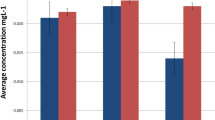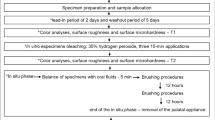Abstract
This work aimed to evaluate the salivary concentration of chemical elements in patients undergoing orthodontic treatment with fixed orthodontic appliances and removable aligners. Twelve Angle Class I and II orthodontic patients undergoing treatment with conventional fixed appliances and 15 patients treated with removable aligners provided unstimulated whole saliva samples before treatment (pre) and after 3 months of treatment (post). The concentration and secretion rate of chemical elements in saliva were determined by total reflection X-ray fluorescence. Differences from pre to post and between groups were determined with the paired T test or Wilcoxon test, and two-way ANOVA, considering P < 0.05. The concentrations of S, Cl, and K decreased, while Zn increased significantly (P < 0.05) between pre and post treatment with the fixed appliance treatment. The salivary secretion rate of S was decreased from pre to post in the fixed appliance group. No differences in the concentration and secretion rate of chemical elements were detected from pre to post in the Invisalign group. Fe secretion rate presented an interaction between time and treatment, with lower secretion at post (P = 0.02) in the Invisalign group. Increased Br secretion rate and decreased Rb, Fe, P, and K in Invisalign patients suggested a better salivary electrolyte profile regarding periodontal bone remodeling. No significant alterations in ions associated with metal corrosion and inflammatory reactions were detected in orthodontic patients under dental plaque control.
Similar content being viewed by others
Data Availability
The authors will provide spreadsheets and research data if required by the editorial board at any moment, or to other researchers after publication of the text.
References
Martin-Camean A, Jos A, Puerto M, Calleja A, Iglesias-Linares A, Solano E, Camean AM (2015) In vivo determination of aluminum, cobalt, chromium, copper, nickel, titanium and vanadium in oral mucosa cells from orthodontic patients with mini-implants by inductively coupled plasma-mass spectrometry (ICP-MS). J Trace Elem Med Biol 32:13–20. https://doi.org/10.1016/j.jtemb.2015.05.001
Natarajan M, Padmanabhan S, Chitharanjan A, Narasimhan M (2011) Evaluation of the genotoxic effects of fixed appliances on oral mucosal cells and the relationship to nickel and chromium concentrations: an in-vivo study. Am J Orthod Dentofac Orthop 140(3):383–388. https://doi.org/10.1016/j.ajodo.2010.07.027
Mikulewicz M, Chojnacka K, Wozniak B, Downarowicz P (2012) Release of metal ions from orthodontic appliances: an in vitro study. Biol Trace Elem Res 146(2):272–280. https://doi.org/10.1007/s12011-011-9233-
Dwivedi A, Tikku T, Khanna R, Maurya RP, Verma G, Murthy RC (2015) Release of nickel and chromium ions in the saliva of patients with fixed orthodontic appliance: an in-vivo study. Natl J Maxillofac Surg 6(1):62–66. https://doi.org/10.4103/0975-5950.168224
Amini F, Rahimi H, Morad G, Mollaei M (2013) The effect of stress on salivary metal ion content in orthodontic patients. Biol Trace Elem Res 155(3):339–343. https://doi.org/10.1007/s12011-013-9812-7
Lages RB, Bridi EC, Perez CA, Basting RT (2017) Salivary levels of nickel, chromium, iron, and copper in patients treated with metal or esthetic fixed orthodontic appliances: a retrospective cohort study. J Trace Elemen Med Biol 40:67–71. https://doi.org/10.1016/j.jtemb.2016.12.011
Jurela A, Verzak Z, Brailo V, Skrinjar I, Sudarevic K, Jankovic B (2018) Salivary electrolytes in patients with metallic and ceramic orthodontic brackets. Acta Stomatol Croat 52(1):32–36. https://doi.org/10.15644/asc52/1/5
Kameda T, Oda H, Ohkuma K, Sano N, Batbayar N, Terashima Y, Sato S, Terada K (2014) Microbiologically influenced corrosion of orthodontic metallic appliances. Dent Mater J 33(2):187–195. https://doi.org/10.4012/dmj.2013-297
Brandao GA, Simas RM, de Almeida LM, da Silva JM, Meneghim Mde C, Pereira AC, de Almeida HA, Brandao AM (2013) Evaluation of ionic degradation and slot corrosion of metallic brackets by the action of different dentifrices. Dental Press J Orthod 18(1):86–93. https://doi.org/10.1590/s2176-94512013000100019
Fernandez-Minano E, Ortiz C, Vicente A, Calvo Guirado JL, Ortiz AJ (2011) Metallic ion content and damage to the DNA in oral mucosa cells of children with fixed orthodontic appliances. Biometals 24(5):935. https://doi.org/10.1007/s10534-011-9448-z
Dallel I, Ben Salem I, Merghni A, Bellalah W, Neffati F, Tobji S, Ben Amor A, Mastouri M (2020) Influence of orthodontic appliance type on salivary parameters during treatment. Angle Orthod 90:532–538. https://doi.org/10.2319/082919-562.1
Verrusio C, Iorio-Siciliano V, Blasi A, Leuci S, Adamo D, Nicolo M (2018) The effect of orthodontic treatment on periodontal tissue inflammation: a systematic review. Quintessence Int 49(1):69–77. https://doi.org/10.3290/j.qi.a39225
Dermience M, Lognay G, Mathieu F, Goyens P (2015) Effects of thirty elements on bone metabolism. J Trace Elemen Med Biol 32:86–106. https://doi.org/10.1016/j.jtemb.2015.06.005
Mahdavi-Roshan M, Ebrahimi M, Ebrahimi A (2015) Copper, magnesium, zinc and calcium status in osteopenic and osteoporotic post-menopausal women. Clin Cases Miner Bone Metab 12(1):18–21. https://doi.org/10.11138/ccmbm/2015.12.1.018
Saghiri MA, Orangi J, Asatourian A, Sorenson CM, Sheibani N (2016) Functional role of inorganic trace elements in angiogenesis part III: (Ti, Li, Ce, As, Hg, Va, Nb and Pb). Crit Rev Oncol Hematol 98:290–301. https://doi.org/10.1016/j.critrevonc.2015.10.004
Schaefer I, Braumann B (2010) Halitosis, oral health and quality of life during treatment with Invisalign((R)) and the effect of a low-dose chlorhexidine solution. J Orofac Orthop 71(6):430–441. https://doi.org/10.1007/s00056-010-1040-6
Miethke RR, Brauner K (2007) A Comparison of the periodontal health of patients during treatment with the Invisalign system and with fixed lingual appliances. J Orofac Orthop 63(3):223–231. https://doi.org/10.1007/s00056-007-0655-8
Miethke RR, Vogt S (2005) A comparison of the periodontal health of patients during treatment with the Invisalign system and with fixed orthodontic appliances. J Orofac Orthop 63(3):219–229. https://doi.org/10.1007/s00056-005-0436-1
Kravitz ND, Kusnoto B, BeGole E, Obrez A, Agran B (2009) How well does Invisalign work? A prospective clinical study evaluating the efficacy of tooth movement with Invisalign. Am J Orthod Dentofac Orthop 135(1):27–35. https://doi.org/10.1016/j.ajodo.2007.05.018
Ke Y, Zhu Y, Zhu M (2019) A comparison of treatment effectiveness between clear aligner and fixed appliance therapies. BMC Oral Health 19(1):24. https://doi.org/10.1186/s12903-018-0695-z
Saito M, Arakaki R, Yamada A, Tsunematsu T, Kudo Y, Ishimaru N (2016) Molecular mechanisms of nickel allergy. Int J Mol Sci 17(2). https://doi.org/10.3390/ijms17020202
Fang D, Li F, Zhang Y, Bai Y, Wu BM (2020) Changes in mechanical properties, surface morphology, structure, and composition of Invisalign material in the oral environment. Am J Orthod Dentofac Orthop 157(6):745–753. https://doi.org/10.1016/j.ajodo.2019.05.023
Imani MM, Mozaffari HR, Ramezani M, Sadeghi M (2019) Effect of fixed orthodontic treatment on salivary nickel and chromium levels: a systematic review and meta-analysis of observational studies. Dent J 7 (1). https://doi.org/10.3390/dj7010021
Mystkowska J, Niemirowicz-Laskowska K, Lysik D, Tokajuk G, Dabrowski JR, Bucki R (2018) The role of oral cavity biofilm on metallic biomaterial surface destruction-corrosion and friction aspects. Int J Mol Sci 19 (3). https://doi.org/10.3390/ijms19030743
Wendl B, Wiltsche H, Lankmayr E, Winsauer H, Walter A, Muchitsch A, Jakse N, Wendl M, Wendl T (2017) Metal release profiles of orthodontic bands, brackets, and wires: an in vitro study. J Orofac Orthop 78(6):494–503. https://doi.org/10.1007/s00056-017-0107-z
Eliades T, Athanasiou AE (2002) In vivo aging of orthodontic alloys: implications for corrosion potential, nickel release, and biocompatibility. Angle Orthod 72(3):222–237. https://doi.org/10.1043/0003-3219(2002)072<0222:IVAOOA>2.0.CO;2
Silva Andrade A, Marcon Szymanski M, Hashizume LN, Santos Mundstock K, Ferraz Goularte J, Hauber Gameiro G (2018) Evaluation of stress biomarkers and electrolytes in saliva of patients undergoing fixed orthodontic treatment. Minerva Stomatol 67(4):172–178. https://doi.org/10.23736/S0026-4970.18.04025-6
Gjerdet NR, Erichsen ES, Remlo HE, Evjen G (1991) Nickel and iron in saliva of patients with fixed orthodontic appliances. Acta Odontol Scand 49(2):73–78. https://doi.org/10.3109/00016359109005889
Matos de Souza R, Macedo de Menezes L (2008) Nickel, chromium and iron levels in the saliva of patients with simulated fixed orthodontic appliances. Angle Orthod 78(2):345–350. https://doi.org/10.2319/111806-466.1
Amini F, Jafari A, Amini P, Sepasi S (2012) Metal ion release from fixed orthodontic appliances--an in vivo study. Eur J Orthod 34(1):126–130. https://doi.org/10.1093/ejo/cjq181
Karnam SK, Reddy AN, Manjith CM (2012) Comparison of metal ion release from different bracket archwire combinations: an in vitro study. J Contemp Dent Pract 13(3):376–381. https://doi.org/10.5005/jp-journals-10024-1154
Krespi YP, Shrime MG, Kacker A (2006) The relationship between oral malodor and volatile sulfur compound-producing bacteria. Otolaryngol Head Neck Surg 135(5):671–676. https://doi.org/10.1016/j.otohns.2005.09.036
Costacurta M, Petrini M, Biferi V, Arcuri C, Spoto G, Docimo R (2019) The correlation between different techniques for the evaluation of oral malodour in children with and without orthodontic treatment. Eur J Paediatr Dent 20(3):233–236. https://doi.org/10.23804/ejpd.2019.20.03.12
Sokucu O, Akpinar A, Ozdemir H, Birlik M, Calisir M (2016) The effect of fixed appliances on oral malodor from beginning of treatment till 1 year. BMC Oral Health 16:14. https://doi.org/10.1186/s12903-016-0174-3
Li Y, Hu B, Liu Y, Ding G, Zhang C, Wang S (2009) The effects of fixed orthodontic appliances on saliva flow rate and saliva electrolyte concentrations. J Oral Rehabil 36(11):781–785. https://doi.org/10.1111/j.1365-2842.2009.01993.x
Proctor GB (2016) The physiology of salivary secretion. Periodontol 70(1):11–25. https://doi.org/10.1111/prd.12116
Karkhanechi M, Chow D, Sipkin J, Sherman D, Boylan RJ, Norman RG, Craig RG, Cisneros GJ (2013) Periodontal status of adult patients treated with fixed buccal appliances and removable aligners over one year of active orthodontic therapy. Angle Orthod 83(1):146–151. https://doi.org/10.2319/031212-217.1
Chakraborty S, Tewari S, Sharma RK, Narula SC, Ghalaut PS, Ghalaut V (2014) Impact of iron deficiency anemia on chronic periodontitis and superoxide dismutase activity: a cross-sectional study. J Periodontal Implant Sci 44(2):57–64. https://doi.org/10.5051/jpis.2014.44.2.57
Inonu E, Hakki SS, Kayis SA, Nielsen FH (2019) The association between some macro and trace elements in saliva and periodontal status. Biol Trace Elem Res 197:35–42. https://doi.org/10.1007/s12011-019-01977-z
Ouyang Z, Huang Q, Liu B, Wu H, Liu T, Liu Y (2019) Rubidium chloride targets Jnk/p38-mediated NF-kappaB activation to attenuate osteoclastogenesis and facilitate osteoblastogenesis. Front Pharmacol 10:584. https://doi.org/10.3389/fphar.2019.00584
Scancar J, Milacic R, Benedik M, Bukovec P (2000) Determination of trace elements and calcium in bone of the human iliac crest by atomic absorption spectrometry. Clin Chim Acta 293(1-2):187–197. https://doi.org/10.1016/s0009-8981(99)00239-9
McCall AS, Cummings CF, Bhave G, Vanacore R, Page-McCaw A, Hudson BG (2014) Bromine is an essential trace element for assembly of collagen IV scaffolds in tissue development and architecture. Cell 157(6):1380–1392. https://doi.org/10.1016/j.cell.2014.05.009
Acknowledgments
The authors thank the Integrale (Londrina, PR, Brazil) and Rotta Institute (Presidente Prudente, SP, Brazil) for authorization to recruit patients and technical support in data sampling.
Funding
This study was supported by the Annual Research Award Program, 2018, Align Technology, Inc. (São José, California – USA) in the form of purchasing consumables and equipment; and the Coordenação de Aperfeiçoamento de Pessoal de Nível Superior (CAPES, Brazil) for grants to ACZ (n. 1763037/2017) and BGD (n.1760771/2017).
Author information
Authors and Affiliations
Contributions
ACZ: Master student in Dentistry responsible for research project design, patient selection, radiographic analysis, hygiene and periodontal control of patients, collection of biological samples, data analysis, and scientific writing. BGD: Master student in Dentistry responsible for research project design, patient selection, hygiene and periodontal control of patients, collection of biological samples, data analysis, and scientific writing. DCMMS: Master student in Dentistry responsible for patient selection, radiographic analysis, dental plaque control, collection of biological samples, data analysis, and scientific writing. LOR: Orthodontist responsible for research project design, patient diagnostics, treatment planning and execution, data analysis, and scientific writing. EIJ: Doctor in physics responsible for TXRF analysis and data spectra analysis, statistical analysis, and scientific writing. ACA: Doctor in physics responsible for research project design, TXRF analysis, statistical analysis, and scientific writing. SPR: Research project coordinator.
Corresponding author
Ethics declarations
Conflicts of Interest
This work received financial support from Align technology Inc., manufacturer of Invisalign orthodontic appliances. This project was awarded the Annual Research Award Program, 2018, promoted by Align technology Inc. which financed the purchase of research reagents and equipment.
Ethics Approval
All study procedures were approved by the Research Ethics Committee of the State University of Londrina, protocol no. 2.682.872. The study was performed in accordance with the recommendations of the Declaration of Helsinki.
Consent to Participate
The participants gave written informed consent before data collection.
Consent for Publication
Not applicable.
Code Availability
Not applicable.
Additional information
Publisher’s Note
Springer Nature remains neutral with regard to jurisdictional claims in published maps and institutional affiliations.
Rights and permissions
About this article
Cite this article
Campos Zeffa, A., Dias, B.G., Silva, D.C.M.S. et al. Influence of Conventional or Invisalign Orthodontic Treatment on Mineral and Trace Element Salivary Levels: Longitudinal Study with Total Reflection X-ray Fluorescence. Biol Trace Elem Res 199, 2565–2572 (2021). https://doi.org/10.1007/s12011-020-02396-1
Received:
Accepted:
Published:
Issue Date:
DOI: https://doi.org/10.1007/s12011-020-02396-1




